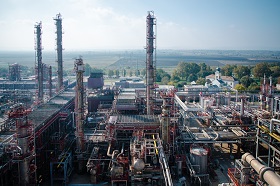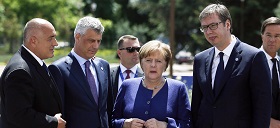President Putin’s visit to Belgrade on January 17, 2019 was a significant domestic political event for Serbia, and an “empty” one for Russia in terms of its prospects in the country, given the events of 2018 and the content of the meeting itself.
The arrival of the President of the Russian Federation did allow Aleksandar Vučić to demonstrate that he enjoys the support both of Washington (which in many ways is doubtful) and Moscow, a city beloved by a large part of the Serbian population. In terms of domestic politics, this position guarantees that the ruling party will score a convincing victory in the snap parliamentary elections, which could be held as early as this spring. The slogan being used to promote Putin’s visit was “one in 300 million” (a reference to a popular Serbian saying that translates “The Serbs and the Russians, there are 300 million of us, but without the Russians, barely enough to fill half a bus”), which turned into a direct response to the opposition’s phrase “1 in 5 million” (which came about in December 2018 as a reaction to the careless statements of the Serbian leader about the opposition’s rallies) and could be used as a “banner” during the election campaign in the country.
It can be stated that, despite its pomposity, Putin’s visit went off without any global breakthroughs or prodigious gestures.
The Russian leader managed to avoid the main traps rather skilfully. Putin did say that “Russia is in favour of Belgrade and Pristina achieving a viable and mutually acceptable solution,” words that Aleksandar Vučić had longed to hear, but continued by reiterating Moscow’s position that this should be done “within the framework of UN Security Council Resolution 1244.” This is precisely what Vučić’s opponents in Serbia are demanding, including the Kosovo Serbs, who fear that “bold and creative” solutions will actually turn out to be a banal form of capitulation and, instead of appeasement, the benefits of European integration will only lead to further crises and the split of the country.
Most importantly, the visit clearly demonstrated to the West that, politically speaking, Russia has no intention of leaving the Balkans, that it understands the intricacies of the domestic political situation and uses them elegantly. Through Serbia (and not only Serbia, like in Slovenia), Russia has influence and weight in all the countries in that region. And the main thing (in terms of it going against the Western concept of economic dominance) is that Russia’s lack of economic influence in the region continues to be compensated quite easily by its historical power and the psychological and emotional communality shared by the Russian and Serbian peoples. It is possible that such a timely visit from the Russian patriarch to the region could bridge the financial void in the Russia–Serbia story.
However, in the short term, all of this default potential may sink into oblivion if Russia does not find a way to become actively involved in the resolution of the Kosovo issue, and in the ethnic issues in the region as a whole.
President Putin’s visit to Belgrade on January 17, 2019 was a significant domestic political event for Serbia, and an “empty” one for Russia in terms of its prospects in the country, given the events of 2018 and the content of the meeting itself.
A Simplified Approach to Assessing the Results of Putin’s Visit
The arrival of the President of the Russian Federation did allow Aleksandar Vučić to demonstrate that he enjoys the support both of Washington (which in many ways is doubtful) and Moscow, a city beloved by a large part of the Serbian population. In terms of domestic politics, this position guarantees that the ruling party will score a convincing victory in the snap parliamentary elections, which could be held as early as this spring. The slogan being used to promote Putin’s visit was “one in 300 million” (a reference to a popular Serbian saying that translates “The Serbs and the Russians, there are 300 million of us, but without the Russians, barely enough to fill half a bus”), which turned into a direct response to the opposition’s phrase “1 in 5 million” (which came about in December 2018 as a reaction to the careless statements of the Serbian leader about the opposition’s rallies) and could be used as a “banner” during the election campaign in the country.
On the other hand, the scale of the open part of the visit clearly did not match the qualitative component. In terms of the size and emotional intensity, Putin’s visit to Belgrade had all the trimmings of a grand performance. Seven hundred journalists, 5000 security service officers, a good part of the Russian cabinet, a squadron of Serbian MiGs to accompany the President’s plane in Belgrade, 120,000 Serbs on the square in front of the Church of Saint Sava chanting “Putin! Putin!” and even two small but indispensable additions to the main program – the timely revelation of an attempted assassination and the free Tsarsky bread in the Maxi shops.
At the same time, the main results of the visit were the streamlined statements about TurkStream, the 21 agreements that will be worth a total of 660 million euros in the future (five of which are concerned with providing electricity to Serbian cities) and the Russian leader’s assertion that the “the resolution of the Kosovo issue should be handled by Belgrade and Pristina, but within the framework of UN Security Council Resolution 1244.”
The following outlines what may at first appear to be the main results of Putin’s visit to Belgrade.
A Tie
Putin’s visit to Belgrade, dare we say, was an historical event. It will take some time before we see its effects – either as a solid result in the Balkans or as the end of Russia in the region. Why is that?
Following the 2000 October Revolution in Yugoslavia, which led to the overthrow of Slobodan Milošević, fierce debates raged in Serbia over why Moscow did nothing to prevent the change of power in Belgrade. They also brought up the fact that Russia “did nothing” in 1995 when Milošević visited Moscow. Just like now, the expectations of ordinary Serbs back then (regardless of what social group they belonged to) were off the charts, and the Serbian leaders wanted to use Moscow to further its own domestic agenda. And, as we all know, there is nothing worse than disappointed expectations.
To be sure, it can be stated that, despite its pomposity, Putin’s visit went off without any global breakthroughs or prodigious gestures. Yet there were many fears about it: that attempts would be made to get Russia to achieve an agreement on the recognition by Belgrade of Kosovo’s independence; that the Serbian side would try to draw Putin into the country’s domestic confrontation; or, more importantly, that the whole deal could undermine pro-Russian sentiments within Serbian society.
The Russian leader managed to avoid the main traps rather skilfully. Putin did say that “Russia is in favour of Belgrade and Pristina achieving a viable and mutually acceptable solution,” words that Aleksandar Vučić had longed to hear, but continued by reiterating Moscow’s position that this should be done “within the framework of UN Security Council Resolution 1244.” This is precisely what Vučić’s opponents in Serbia are demanding, including the Kosovo Serbs, who fear that “bold and creative” solutions will actually turn out to be a banal form of capitulation and, instead of appeasement, the benefits of European integration will only lead to further crises and the split of the country.
Putin was equally skilful in his refusals to engage in the domestic political struggle in Serbia. Presenting Vučić with the Order of Alexander Nevsky and praising him for his personal contribution to the development of bilateral relations (which is certainly fair, as Serbia is the only European country that does not display a hint of anti-Russian sentiment at any level), Putin made note of other Serbian greats who had the honour bestowed upon them in the 19th and early 20th centuries – the founder of independent Serbia Miloš Obrenović and the famous Prime Minister Nikola Pašić. However, Putin politely refused to take part in a mass rally organized by the ruling Serbian Progressive Party (SPP) led by Vučić. The SPP chartered hundreds of buses to bring in activists and employees of government-funded organizations from across the country, attempting to use the meeting with the most popular foreign leader in Serbia to offset the mass protests organized by the opposition. Despite Vučić’s persistence, as well as the fact that Putin’s participation in the rally had been announced a week before his visit to Belgrade, the Russian leader merely thanked the people for their friendly attitude towards Russia. Refusing to support either of the sides in the domestic political confrontation helped prevent any damage being done to the Russophile portion of the opposition. It would seem that, in terms of its positions, Moscow did not lose anything from Putin’s Belgrade visit. But did it win anything? That is the question.
In order to answer this question, it is important to understand the regional context in which the official visit took place.
The Regional Dimension
The Macedonian parliament recently passed a vote on changing the country’s name to the “Republic of North Macedonia,” opening the way to NATO and EU membership. The Hellenic Parliament has not yet voted on the issue. It will do so on January 25, 2019.
Two days before Putin’s visit to Serbia, the U.S. administration addressed the request to lift the customs barriers imposed on goods from Serbia and Bosnia and Herzegovina to Kosovo Albanians. The pressure on the Kosovan authorities to take part in the hearings on the atrocities of the 1990s is thus increasing. Such actions, as well as the developments of the past six months, demonstrate that Washington sees itself as the main arbiter and future guardian of the agreement between Serbia and Kosovo. Donald Trump was candid about this in his December 2018 letters to President of Kosovo Hashim Thaçi and his Serbian counterpart Aleksandar Vučić.
At the same time, the Kosovan and Albanian authorities bilaterally abolished the border regime between the two countries and implemented joint control over crossings, meaning that the two countries have de facto entered the final stages of the “Greater Albania” project. It would seem that such steps would logically put the issue over other “great” countries (for example, Serbia and Croatia) on the agenda too. But we should not count on this right now, as, unlike the Albanians, Belgrade and Zagreb do not have great power behind them.
The only thing that is new in Serbia–Croatia relations are the reasons for the tensions. Tensions themselves are part and parcel of the relationship between the two countries.
In this context, symbolism surrounded the Russian President’s visit to Belgrade. Aleksandar Vučić presented Putin with a Šarplaninac (also known as a Yugoslavian Shepherd Dog, a Macedonian Shepherd Dog and a Kosovan Shepherd Dog). Does it mean he presented Kosovo to Moscow? Probably not. However, it was almost certainly an invitation to step up efforts and an attempt to shift part of the responsibility for the outcome of the negotiations regarding the region onto Russia.
What is more, in the context of the regional trends mentioned above, Putin’s visit can be interpreted not only and not so much as Russia demonstrating its support for Vučić and Serbia, but rather as a meeting with all the region’s Serbian leaders (the leader of the Serbs in Bosnia and Herzegovina Milorad Dodik, the leaders of the Montenegrin opposition Andrija Mandić and Goran Danilović, and the leader of the Serbs in Macedonia Ivan Stoilković). For the first time ever, Putin, albeit it in passing, touched upon the issue of the fragmentation of the Serbian people across a number of states: “There was an attempt to pull the Serbian people about and scatter them across different states, but these decisions are unlikely to be durable if they are not fair.”
What Can Russia Get out of Putin’s Visit?
On the one hand, everything we have mentioned so far can be used to marginalize Moscow’s role in the region.
The ruling party in Serbia will, through the state-controlled media, paint the visit as support for its efforts to cut the “Kosovan knot” and one of the main trump cards for possible parliamentary elections in the future. In this sense, it will tear out a part of the pro-Russian opposition’s program, which is actively participating in the “Union for Serbia” movement, and also deprive it of its main argument that “the government pursues the treacherous policy of recognizing Kosovo and acceding to both the European Union and NATO.” In reality, while Aleksandar Vučić consistently rejects the prospect of Serbia joining NATO, it is clear that the pressure on Belgrade continues to grow. Before Putin’s arrival, the Ministry of Defence of the Republic of Serbia reported that negotiations on the second phase of the Individual Partnership Action Plans (IPAP) with NATO had been successful.
Both a final solution to problem of Macedonia’s name and NATO pressure on Bosnia and Herzegovina indirectly point to the Alliance strengthening its positions in the region. The only recourse available to Belgrad would be either joining NATO or secession of Republika Srpska and work for the creation of the so-called “Great Serbia” as the Albanians do.
The pompousness with which the President of the Russian Federation was received will, from a moral point of view, allow European bureaucracy and the western media to double down on its campaign to stigmatize Russia in the region and accelerate the integration of the Balkans into NATO. At the same time, the economic results of the visit, which have been described by the well-known saying “the mountain gave birth to a mouse,” open the way to marginalizing Russia’s role in the economic structure of the region and the pedalling of this fact on the part of the European Union. We must admit that Aleksandar Vučić covered all the bases here: in the run-up to the visit, he assured all the European ambassadors that Putin’s arrival in Belgrade was in no way connected to Serbia’s main desire – to become a member of the EU. The fact that Russia and Serbia have not yet managed to complete technical negotiations on the creation of a free trade area between the latter and the Eurasian Economic Union (EAEU), which were launched back in 2015, is further evidence of this.
At the same time, the absence of economic breakthroughs indicates that the visit was needed primarily by Belgrade, which had fought so hard for it to take place. The contractual agreements that were reached do, however, demonstrate that Russian business has an interest in the Serbian market. Also, while “digitalization” is seen by many in both countries as a “modern toy of the authorities,” the agreements give IT companies certain opportunities: Russian companies will gain access to the Serbian market and Serbian developers will be involved in Russian projects.
Most importantly, the visit clearly demonstrated to the West that, politically speaking, Russia has no intention of leaving the Balkans, that it understands the intricacies of the domestic political situation and uses them elegantly. Through Serbia (and not only Serbia, like in Slovenia), Russia has influence and weight in all the countries in that region. And the main thing (in terms of it going against the Western concept of economic dominance) is that Russia’s lack of economic influence in the region continues to be compensated quite easily by its historical power and the psychological and emotional communality shared by the Russian and Serbian peoples. It is possible that such a timely visit from the Russian patriarch to the region could bridge the financial void in the Russia–Serbia story.
However, in the short term, all of this default potential may sink into oblivion if Russia does not find a way to become actively involved in the resolution of the Kosovo issue, and in the ethnic issues in the region as a whole. It would be wise for Moscow to include a number of questions on the agenda:
- Why do the European Union and NATO tolerate this kind of Balkans (stagnating politically and economically, and thus combustible and living exclusively in the past)?
- Why does the inclusion of the United States and the United Kingdom in the negotiations on Kosovo does not mean inclusion of Russia?
- Why do both the United States and the European Union turn a blind eye to the growing tension in the region (the emerging split between the Orthodox Church and the radicalization of the Islamic environment)?
Moscow should then propose searching for answers to these questions within the framework of a new international conference on the Balkans.









